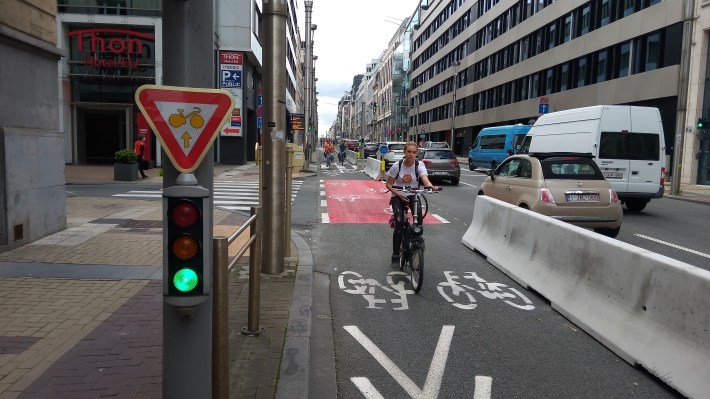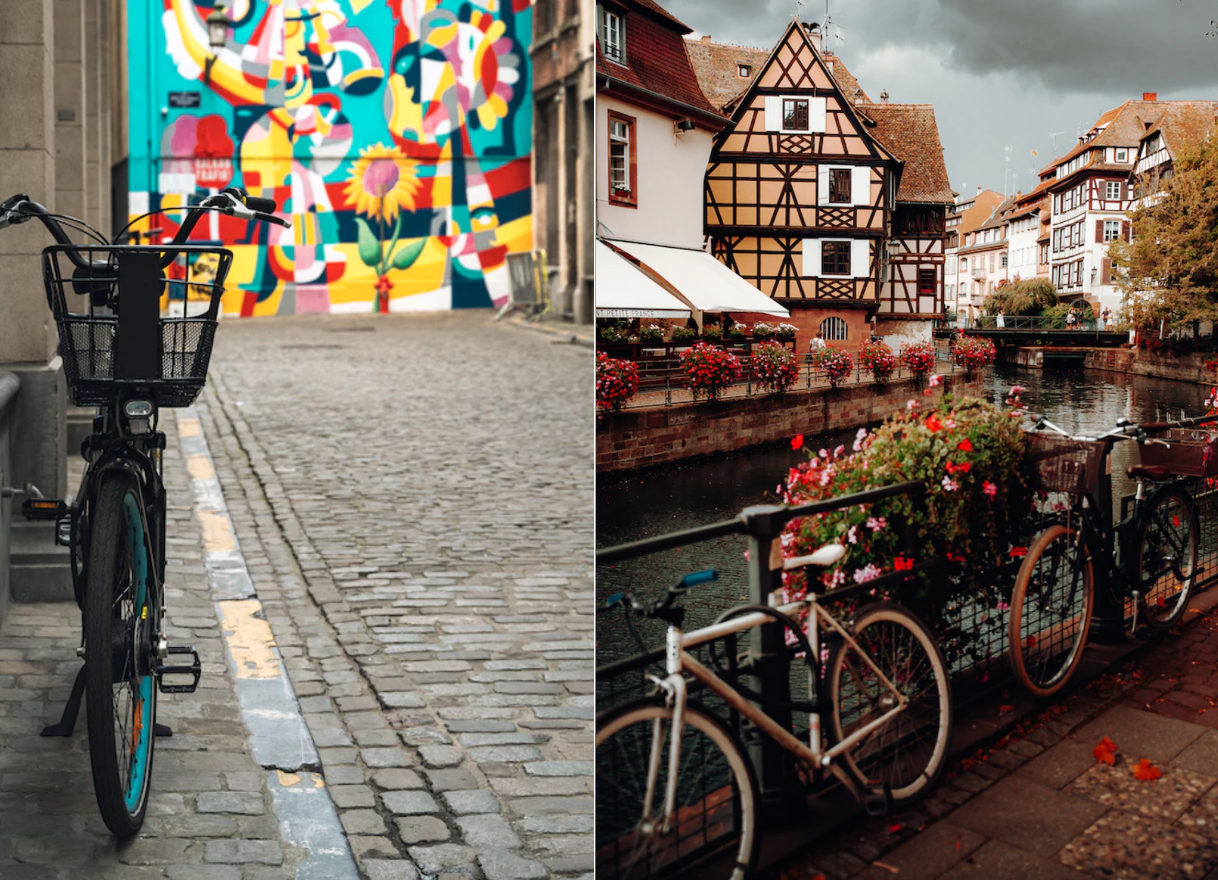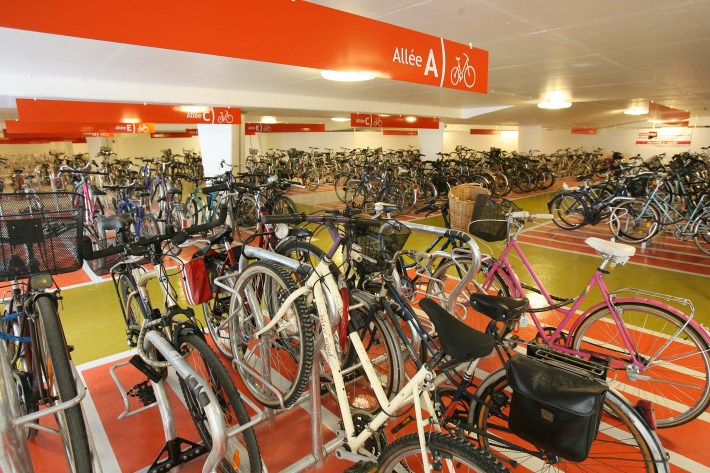This article is part of the “Cycling Through COVID-19” series from world-renowned cycling researchers Ralph Buehler and John Pucher and is published with permission from the authors. In this series, we’ll explore how 14 large cities around the world adjusted their cycling policies during the first years of the COVID-19 pandemic, as well as how those policies contrasted with their approach in the decades prior. In each, Buehler and Pucher also explore how each city’s plans for future investment in cycling infrastructure and programs have been impacted by the pandemic.
Read the rest of the articles in this series as they’re published here, or check out the full paper in Sustainability.
Brussels
Brussels, Belgium’s largest city and the seat of the European Union, does not have a history of cycling. In 2010, only 3.5 percent of all trips in the city were made by bicycle. Since 2010, however, the city has vigorously promoted cycling. Based on bicycle counts from 2010 to 2019 and the recent increases in cycling during the COVID-19 pandemic, local planners estimate that the share of trips by bicycle had reached about 10 percent in early 2022.
During the COVID-19 pandemic, cycling rates increased rapidly. Overall, the city’s bicycle counters detected an increase in the number of bicycle trips by 64 percent between 2019 and 2020 and an additional 20 percent increase between 2020 and 2021.
As in many other cities, trends in cycling varied by location and time of day. Indeed, counters registered declines in commuter bicycle trips from 2019 to 2020, especially during rush hour and in locations close to schools, universities, or office centers. Even many of those locations, however, reported large increases in cycling from 2020 to 2021, with 10 percent more bicycle trips during commute hours in 2021 than in 2019, thus more than rebounding from the decline in 2020.

The city implemented several pro-bicycle measures in response to the COVID-19 pandemic. The city built 50 kilometers of pop-up bicycle lanes that closed gaps in the cycling network to better connect the city center to the rest of the city. The pop-up bicycle lanes were built in locations identified for future bicycle lanes in Brussels’ regional transport plan that had been passed in March 2020, just as the pandemic hit.
Pop-up bicycle lanes were clearly marked and, wherever possible, separated from traffic with concrete barriers or planter boxes. Pop-up-lanes typically take up one car travel lane (3 meters) and are marked at a safe distance from parked cars (80 centimeters). The bicycle lanes are about 1.3 m wide. The city’s goal is to make pop-up bicycle lanes permanent in the future because they account for 33 percent of the current bikeway network. The pop-up bicycle lanes also constitute 17 percent of the planned cycling network for Brussels in 2030, which will have roughly 250 kilometers of bikeways in total. According to local laws, pop-up bicycle lanes can remain in effect for two years and then need to obtain an official building permit in order to be made permanent.
Strasbourg, France
The city of Strasbourg (population 290,000) has had the highest bicycle share of trips of all French cities for decades: increasing from 7 percent in 1997 to 16 percent in 2019. Strasbourg published its first bicycle plan in 1978 and created new plans in 1994, 2010, and 2020.
Strasbourg is part of the Eurometropole region, which has 510,000 inhabitants and 33 jurisdictions, and bicycle planning has been coordinated across jurisdictional boundaries within the entire region. Prior to the COVID-19 pandemic, the region had 700 kilometers of bikeways, but with important gaps in connectivity — mostly between the city center and the suburbs areas, and in deprived neighborhoods. Since 2008, the city has implemented cycling infrastructure and traffic calming whenever possible during street improvement projects.
Strasbourg implemented few new policies in direct response to the COVID-19 pandemic. The city built six pop-up bicycle lanes and initiated a public relations campaign that promoted cycling as the ideal mode of transport for commuting and social distancing during the COVID-19 pandemic. Available bicycle counter data show a 19 percent increase in cycling in Strasbourg between 2019 and 2021.

A new city government took office in spring 2020. It decided to establish an accelerated cycling program for the next five years, but that pro-cycling plan is not directly related to the COVID-19 pandemic. The program is called “Plan Vélo’’ and aims to expand and improve the network of bikeways as well as complementary programs and services related to cycling. A budget of EUR 100 million was allocated to implement this plan. Plan Vélo focuses on connecting the bikeways between cities and villages in the Eurometropole area. The goal is to add 120 km of bikeways by 2026, upgrade 20 large intersections, and close 50 crucial gaps in the current bikeway network. This will include the elimination of car travel lanes and on-street car parking on many roads.
The plan also calls for expanding the area’s longer distance “cycle highways” network called Vélostras, including the important Vélostras 1 ring that connects many bikeways. Vélostras was launched in 2013 and will eventually be 130 kilometers long. About 90 kilometers of the planned Vélostras network already exists, but often at lower quality, so that much of the work will entail upgrading the existing parts of the network to higher design standards.
The region plans to roughly double the regional modal share of cycling from 11 percent in 2020 to 20 percent by 2030. The City of Strasbourg itself had already reached 16 percent by 2020. Currently, 30 percent of trips shorter than five kilometers are made by car. The new Plan Vélo aims to shift those trips to more sustainable travel modes — including cycling. Following the example of many European cities, since 2020 Strasbourg has been offering a subsidy of 300–500 euros for purchases of e-bikes, with the amount depending on type and cost of the e-bikes.







